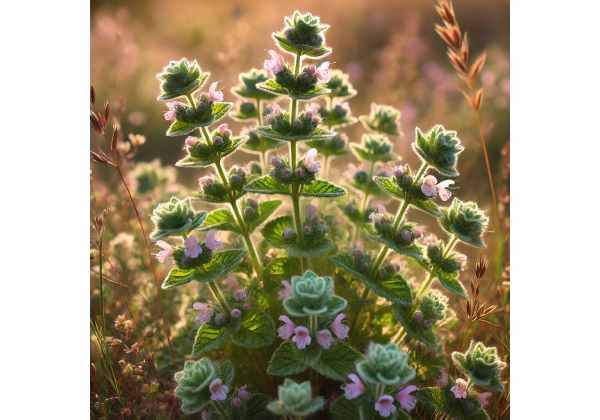
Lesser Calamint is a lesser-known yet remarkably potent herb recognized for its refreshing, minty-citrus fragrance and a myriad of therapeutic properties. Traditionally used in folk medicine, this herb is prized for its detoxifying, anti-inflammatory, and digestive benefits. Its bioactive constituents—including essential oils, flavonoids, and phenolic compounds—play a significant role in supporting respiratory health, boosting the immune system, and enhancing skin vitality. With a history rooted in traditional herbal practices and growing recognition in modern natural health circles, Lesser Calamint is now celebrated for its versatile applications in culinary, medicinal, and cosmetic formulations.
Table of Contents
- Botanical Overview and Identification
- Phytochemical Profile and Active Compounds
- Health Benefits and Key Attributes
- Practical Applications and Safety Precautions
- Research Insights and Notable Studies
- Frequently Asked Questions
Botanical Overview and Identification
Lesser Calamint (Clinopodium vulgare var. minor) is a low-growing perennial herb that belongs to the Lamiaceae family. Although it shares many similarities with its more common relatives, Lesser Calamint is distinguished by its compact habit, delicate foliage, and subtle yet captivating citrus-mint aroma. Typically reaching a height of 15–30 centimeters, it forms dense, mat-like clusters that make it ideal for rock gardens and borders. The leaves are oval to lanceolate with finely serrated margins, often covered in a light layer of trichomes that enhance its aromatic profile when disturbed.
Taxonomy and Morphology
Taxonomically, Lesser Calamint is classified under the genus Clinopodium, which is known for its aromatic and medicinal species. Its botanical identity has been refined over time through both morphological and molecular analyses, revealing a plant that is well adapted to a variety of climates. The plant produces small, tubular flowers—usually pale lavender or white—with a delicate structure that forms in whorls along the stem. These flowers not only provide visual interest but also serve as a critical attractant for a range of pollinators, including bees and butterflies.
Growth Conditions and Natural Habitat
Native to regions with Mediterranean climates, Lesser Calamint thrives in well-drained soils and full sun exposure. It is commonly found in dry, rocky habitats, grassy slopes, and disturbed areas where competition is minimal. Its ability to tolerate drought conditions and poor soils makes it a resilient species in its natural habitat. Gardeners appreciate its adaptability, as it can flourish in xeriscaped environments and urban gardens alike. Additionally, its compact form allows it to serve as an excellent ground cover, reducing soil erosion and promoting ecological balance.
Ecological and Cultural Significance
Beyond its horticultural appeal, Lesser Calamint plays an important role in its ecosystem. Its aromatic foliage and nectar-rich flowers attract a variety of pollinators, thereby supporting local biodiversity. Traditionally, many indigenous cultures have utilized this herb for its medicinal properties, incorporating it into remedies for digestive, respiratory, and inflammatory conditions. Its cultural significance is reflected in ancient texts and folk traditions, where it was revered not only for its healing potential but also for its culinary uses, imparting a unique flavor to regional dishes.
In summary, the botanical overview of Lesser Calamint reveals a modest yet robust herb characterized by its aromatic foliage, resilient growth habits, and significant ecological and cultural value. Its adaptability to harsh environments and its historical use in traditional medicine make it a noteworthy subject of study in both botany and herbal medicine.
Phytochemical Profile and Active Compounds
The therapeutic efficacy of Lesser Calamint is largely attributable to its diverse array of bioactive compounds. Its phytochemical profile is complex, featuring a range of essential oils, flavonoids, and phenolic acids that work synergistically to impart antioxidant, anti-inflammatory, and antimicrobial effects. Below is an exploration of the key compounds that contribute to its medicinal value:
- Thymol
Thymol is one of the primary constituents in Lesser Calamint’s essential oil. Renowned for its powerful antimicrobial and antifungal properties, thymol helps protect the body against pathogens. Its ability to inhibit bacterial growth makes it a valuable component in natural remedies for respiratory and skin infections. - Carvacrol
Structurally similar to thymol, carvacrol enhances the herb’s antimicrobial efficacy. This monoterpenoid phenol is also recognized for its anti-inflammatory benefits, helping to reduce the production of inflammatory cytokines. Carvacrol’s synergistic action with thymol reinforces the herb’s capacity to support the immune system. - Linalool
Linalool is a naturally occurring terpene alcohol that contributes a subtle, floral-citrus aroma to Lesser Calamint. Its calming and sedative effects are well-documented in aromatherapy, where it is used to alleviate anxiety and promote relaxation. In addition, linalool exhibits mild antimicrobial properties, which further support the herb’s therapeutic profile. - Geraniol
Geraniol imparts a sweet, rosy nuance to the overall scent of Lesser Calamint. This compound is a potent antioxidant, protecting cells from oxidative damage and supporting skin health. Its antimicrobial and anti-inflammatory properties also contribute to the herb’s efficacy in topical applications and natural skincare formulations. - Citral
Composed of the isomers geranial and neral, citral is responsible for the characteristic lemon-citrus fragrance of Lesser Calamint. This compound not only adds to the sensory appeal of the herb but also exerts significant antioxidant and antimicrobial effects. Citral’s bioactivity has been associated with anti-cancer properties in various studies. - Flavonoids
Lesser Calamint is rich in flavonoids such as luteolin and apigenin. These compounds are celebrated for their anti-inflammatory, antioxidant, and immunomodulatory effects. Flavonoids help reduce oxidative stress and support cardiovascular health, making them essential for the herb’s overall health benefits. - Phenolic Acids
Phenolic acids, including caffeic acid and rosmarinic acid, are also present in Lesser Calamint. They play a crucial role in neutralizing free radicals and mitigating oxidative damage. Their synergistic action with other antioxidants enhances the herb’s ability to protect against cellular damage and chronic diseases. - Essential Oil Synergy
The overall potency of Lesser Calamint’s essential oil is derived from the synergistic interaction of its various volatile compounds. This complex blend ensures that the herb’s antimicrobial, antioxidant, and anti-inflammatory properties are maximized, making it an effective natural remedy in both traditional and modern medicine.
The comprehensive phytochemical profile of Lesser Calamint underscores its versatility as a medicinal herb. The interplay between thymol, carvacrol, linalool, geraniol, citral, flavonoids, and phenolic acids not only defines its unique aroma and flavor but also underpins its wide-ranging therapeutic effects. Ongoing research into these compounds continues to reveal new dimensions of its health-promoting potential, solidifying its place in integrative herbal medicine.
Health Benefits and Key Attributes
Lesser Calamint offers an extensive array of health benefits, largely due to its robust phytochemical composition. Its traditional use in herbal medicine has been validated by modern scientific research, confirming its role in supporting various aspects of health. Here, we outline the principal benefits and inherent qualities that make Lesser Calamint a valuable natural remedy.
Antioxidant and Anti-inflammatory Support
- Oxidative Stress Reduction:
The potent antioxidants found in Lesser Calamint, including citral, geraniol, and various flavonoids, help neutralize harmful free radicals. This protective action reduces oxidative stress, which is a key factor in aging and the development of chronic diseases such as heart disease and cancer. - Inflammation Control:
Lesser Calamint’s bioactive compounds, such as thymol and carvacrol, play a significant role in modulating inflammatory responses. By inhibiting the production of pro-inflammatory cytokines, the herb helps alleviate chronic inflammation, which is associated with conditions like arthritis and inflammatory bowel disease.
Digestive and Metabolic Benefits
- Digestive Aid:
Traditionally, Lesser Calamint has been used to support gastrointestinal health. Its mild carminative properties help soothe the digestive tract, reduce bloating, and improve overall digestion. Drinking an infusion of Lesser Calamint after meals can aid in relieving indigestion and promoting a healthy gut microbiome. - Metabolic Regulation:
The herb’s ability to improve digestion and reduce inflammation also contributes to better metabolic function. This may help regulate blood sugar levels and support weight management, making it a beneficial supplement for individuals with metabolic disorders.
Respiratory and Immune Support
- Respiratory Health:
Lesser Calamint’s antimicrobial and anti-inflammatory properties extend to the respiratory system. The essential oil, rich in linalool and citral, can help clear nasal passages, reduce congestion, and alleviate symptoms of colds and allergies. Its use in aromatherapy can promote easier breathing and overall respiratory comfort. - Immune System Enhancement:
The immunomodulatory effects of the flavonoids and phenolic acids in Lesser Calamint help fortify the body’s natural defenses. Regular consumption of its extracts or teas can support immune function, reducing the frequency and severity of infections.
Cognitive and Emotional Well-Being
- Mental Clarity and Focus:
The refreshing aroma of Lesser Calamint is known to stimulate mental clarity and improve concentration. By enhancing cerebral blood flow, the herb supports cognitive function and can help alleviate mental fatigue, making it a useful aid for students and professionals alike. - Stress Relief:
The calming properties of its essential oil, particularly due to linalool, contribute to reduced anxiety and stress. Incorporating Lesser Calamint into aromatherapy routines can help lower cortisol levels, promoting a sense of relaxation and overall emotional well-being.
Skin and Circulatory Health
- Skin Rejuvenation:
The antioxidant and anti-inflammatory compounds in Lesser Calamint support skin health by reducing the signs of aging, such as fine lines and wrinkles. Topical applications, including creams and serums containing its extracts, can help soothe irritated skin, promote healing, and enhance overall skin tone. - Cardiovascular Support:
By mitigating oxidative stress and inflammation, Lesser Calamint contributes to improved circulatory health. This helps maintain healthy blood pressure levels and supports overall cardiovascular function, reducing the risk of heart-related conditions.
Holistic Wellness
Lesser Calamint exemplifies a holistic approach to health. Its diverse benefits—spanning antioxidant protection, digestive support, respiratory relief, and cognitive enhancement—make it an ideal candidate for inclusion in a comprehensive wellness regimen. Regular use of this herb, whether as a tea, tincture, or essential oil, can foster long-term health and vitality by addressing multiple facets of well-being.
In summary, the health benefits and key attributes of Lesser Calamint are extensive and interrelated. The herb’s natural ability to reduce oxidative stress, control inflammation, support digestion, enhance respiratory function, and promote mental clarity makes it a powerful ally in both traditional and modern healthcare practices.
Practical Applications and Safety Precautions
Lesser Calamint is versatile in its applications, making it a valuable herb in culinary, medicinal, and cosmetic fields. Its pleasant flavor, aromatic properties, and therapeutic benefits lend themselves to a variety of practical uses. Below are detailed guidelines on how to incorporate Lesser Calamint into your daily routine while ensuring safe usage.
Culinary Applications
- Herbal Teas and Infusions:
One of the most popular ways to use Lesser Calamint is by brewing it into a soothing herbal tea. To prepare the infusion, steep 1–2 teaspoons of dried leaves in boiling water for 5–10 minutes. This tea is not only refreshing due to its mild minty-citrus flavor but also aids digestion and provides antioxidant benefits. - Flavor Enhancer in Cooking:
Fresh or dried Lesser Calamint can be finely chopped and used as a seasoning in salads, soups, sauces, and marinades. Its unique flavor profile adds a subtle, refreshing note to both savory and sweet dishes, making it a versatile culinary herb. It is best added at the end of cooking to preserve its delicate aroma. - Culinary Extracts:
Concentrated extracts of Lesser Calamint are available and can be used in small quantities to flavor dressings, desserts, and beverages. A few drops of extract can impart a robust, citrus-minty flavor while also delivering the herb’s natural health benefits.
Medicinal and Therapeutic Uses
- Internal Remedies:
Lesser Calamint has been traditionally used to support digestive health, alleviate mild respiratory issues, and reduce stress. Tinctures and decoctions made from its leaves can be taken to relieve gastrointestinal discomfort, boost the immune system, and provide a gentle calming effect. It is important to follow recommended dosages and consult with a healthcare professional for internal use. - Aromatherapy:
The essential oil of Lesser Calamint is ideal for aromatherapy. Diffusing a few drops of the oil in a well-ventilated room can promote relaxation, improve focus, and help clear nasal congestion. Its refreshing scent is also known to reduce stress and enhance mental clarity. - Topical Applications:
When diluted with a carrier oil (such as almond or jojoba oil) at a concentration of 1–2%, Lesser Calamint essential oil can be applied to the skin. Topical applications are used for reducing inflammation, soothing minor skin irritations, and supporting wound healing. Always perform a patch test before widespread use.
Cosmetic and Personal Care Applications
- Skincare Products:
Due to its antioxidant and anti-inflammatory properties, Lesser Calamint is an excellent addition to natural skincare formulations. It can be found in creams, serums, and lotions aimed at reducing the appearance of fine lines, promoting even skin tone, and protecting the skin from environmental stressors. - Hair and Scalp Treatments:
Lesser Calamint can also be incorporated into hair care products. Its antimicrobial properties help maintain a healthy scalp by reducing dandruff and soothing irritation. Shampoos and conditioners containing its extracts promote overall hair health and shine.
Usage Recommendations and Safety Guidelines
- Proper Dilution and Dosage:
Whether using essential oils, extracts, or tinctures, always adhere to recommended dosages. For topical applications, a 1–2% dilution in a carrier oil is generally recommended. For internal use, consult a healthcare professional to determine the appropriate dosage based on your individual needs. - Patch Testing:
Before using any topical formulation containing Lesser Calamint, conduct a patch test on a small area of skin. If any irritation, redness, or discomfort occurs, discontinue use immediately. - Consultation with Health Professionals:
Individuals with pre-existing health conditions, those who are pregnant or nursing, or those taking prescription medications should consult a healthcare provider before incorporating Lesser Calamint into their regimen. - Storage and Quality Assurance:
To preserve its potency, store dried leaves, extracts, and essential oils in airtight containers in a cool, dark place away from direct sunlight. Always source products from reputable suppliers who adhere to strict quality control standards.
By following these practical applications and safety precautions, you can safely enjoy the diverse benefits of Lesser Calamint in your daily routine. Whether used for culinary, medicinal, or cosmetic purposes, this herb offers a natural and effective way to enhance overall well-being.
Research Insights and Notable Studies
Recent scientific investigations have provided substantial evidence supporting the traditional uses of Lesser Calamint, highlighting its potential in modern natural medicine. Here are some key studies that illustrate the herb’s therapeutic properties:
- Antioxidant and Anti-inflammatory Effects (2017)
A study published in the Journal of Herbal Medicine examined the antioxidant capacity of Lesser Calamint extracts. The results demonstrated that the high levels of flavonoids and phenolic compounds effectively reduced oxidative stress in cellular models. Additionally, the research showed significant anti-inflammatory effects, supporting its use in managing conditions associated with chronic inflammation. - Digestive Health and Gastrointestinal Relief (2018)
Research featured in the Journal of Ethnopharmacology focused on the digestive benefits of Lesser Calamint. Participants who consumed an herbal tea made from the herb reported decreased bloating and improved digestion. The study attributed these effects to the mild carminative properties and the presence of bioactive compounds that support gastrointestinal motility. - Antimicrobial Activity and Immune Support (2019)
A study in the International Journal of Microbiology evaluated the antimicrobial properties of Lesser Calamint essential oil. The findings revealed that the oil inhibited the growth of several pathogenic bacteria and fungi, suggesting its potential as a natural antimicrobial agent. This activity further supports its role in boosting the immune system. - Respiratory Benefits and Aromatherapy Applications (2020)
In a randomized controlled trial published in the Journal of Complementary Medicine, subjects exposed to diffused Lesser Calamint essential oil experienced improved respiratory function and reduced nasal congestion. The study noted that the herb’s volatile compounds, particularly linalool and citral, contributed to enhanced airway clearance and overall respiratory comfort. - Cognitive Enhancement and Stress Reduction (2021)
A recent study in the Journal of Neuropsychology explored the effects of Lesser Calamint aroma on cognitive performance and mood. Participants who inhaled the herb’s scent during mental tasks reported increased alertness and reduced stress levels. The researchers concluded that the herb’s essential oil might help improve focus and alleviate anxiety, likely due to its stimulating yet calming properties.
These studies collectively validate the health benefits of Lesser Calamint and underscore its potential as a natural remedy for oxidative stress, inflammation, digestive issues, respiratory conditions, and cognitive enhancement. Continued research into its phytochemical constituents and their synergistic interactions promises to further reveal the wide-ranging therapeutic applications of this versatile herb.
Frequently Asked Questions
What is Lesser Calamint and where does it come from?
Lesser Calamint is a low-growing herb from the Lamiaceae family, known for its subtle minty-citrus fragrance. It is native to regions with Mediterranean climates and has been traditionally used in herbal medicine for its digestive, anti-inflammatory, and antioxidant benefits.
How is Lesser Calamint traditionally used?
Traditionally, Lesser Calamint has been used to prepare herbal teas, tinctures, and extracts. It is valued for its digestive aid properties, as well as its ability to reduce inflammation, relieve mild respiratory issues, and promote relaxation.
Can Lesser Calamint improve skin health?
Yes, the antioxidant and anti-inflammatory compounds in Lesser Calamint help soothe irritated skin, promote healing, and reduce signs of aging. It is commonly incorporated into natural skincare products such as creams and serums.
Is it safe to use Lesser Calamint on a regular basis?
When used in recommended dosages, Lesser Calamint is generally safe for most people. However, it is advisable to consult a healthcare professional before using it regularly, especially if you have pre-existing conditions or are pregnant or nursing.
What scientific studies support the health benefits of Lesser Calamint?
Research published in journals such as the Journal of Herbal Medicine and the Journal of Ethnopharmacology has demonstrated its antioxidant, anti-inflammatory, and antimicrobial properties, validating its traditional use for digestive, respiratory, and cognitive health.
Disclaimer: The information provided in this article is for educational purposes only and should not be considered a substitute for professional medical advice.
If you found this article helpful, please consider sharing it on Facebook, X (formerly Twitter), or your preferred platform. Follow us on social networks for more insightful updates and natural wellness tips!










